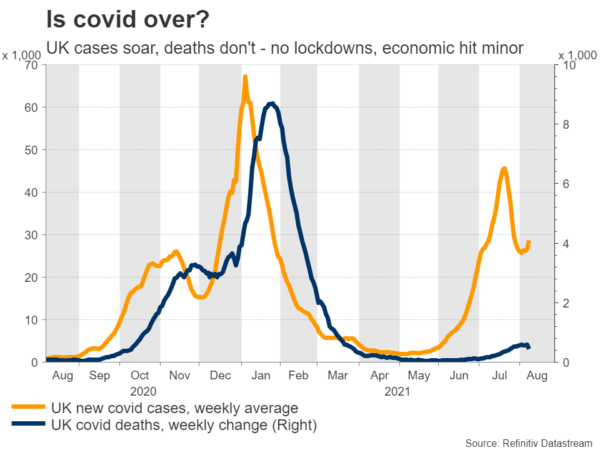British economic growth data for Q2 will hit the markets at 06:00 GMT Thursday. Forecasts point to a solid report as widespread vaccinations enabled the reopening of the economy. The Bank of England took another step towards normalization last week and if the economy continues to perform, it will probably exit asset purchases this year. Sterling seems attractive.
Firing up
The British economic engine started revving again in the second quarter as vaccinations went into overdrive, unchaining consumers and businesses. Forecasts suggest the economy grew by 4.8% in the quarter ending in June, bringing the yearly growth rate to 15%.
Beyond the GDP numbers, markets will also pay close attention to business investment. This is the forward-looking element of economic growth. For all this momentum to be sustained moving forward, businesses need to start investing more heavily.
Overall, the outlook for the British economy remains bright. The Delta outbreak has gotten a lot of headlines lately, but it’s not a huge risk. Vaccines have ensured that both hospitalizations and covid deaths remain very low, so the economic impact will be minor.
The real risk is what happens to unemployment now that the government’s job-protecting programs are ending. The furlough scheme has already been rolled back and will end completely in late September, risking a spike in unemployment. On the bright side, the Bank of England thinks that won’t happen, amid mounting reports of open job positions and businesses struggling to fill vacancies.
BoE gets the ball rolling
The Bank of England has started to beat the normalization drums. Last week, policymakers signaled that interest rates will likely be raised in late 2022, assuming the economy continues to perform. But the most crucial signal was on asset purchases.
Once the Bank Rate hits 0.5%, the BoE will stop reinvesting those bonds that mature on its balance sheet, essentially draining liquidity out of the sterling market. This means that after two rate increases, the BoE will begin quantitative tightening like the Fed did back in 2017-2019.
It looks like the BoE’s game plan is to end asset purchases this year, raise interest rates next year, and then start quantitative tightening.
That’s fantastic news for sterling in the longer term. When a central bank drains liquidity from the market, that ultimately pushes bond yields higher, making its currency more attractive from a relative interest rate point of view.
Sterling vs euro and yen
So the outlook for the pound seems promising, but against what? The Fed, the Bank of Canada, and the Reserve Bank of New Zealand are also moving towards higher interest rates, so any future gains in sterling might not show up against those currencies.
Instead, the pound could shine mainly against the euro and the yen. Neither the European Central Bank nor the Bank of Japan will play the normalization game anytime soon, which implies that their currencies will likely struggle in an environment where other central banks are normalizing.
Taking a technical look at euro/sterling, if sellers manage to pierce below the 0.8465 barrier, their next target could be the January 2020 lows at 0.8390.
On the upside, the bulls might encounter initial resistance around 0.8560. If violated, the next crucial zone is around the recent high of 0.8670.
